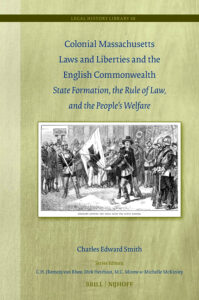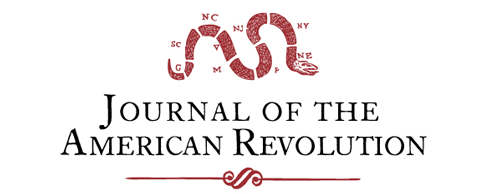BOOK REVIEW: Colonial Massachusetts Laws and Liberties and the English Commonwealth: State Formation, the Rule of Law, and the People’s Welfare by Charles Edward Smith (Leiden: Brill, 2024). Hardcover $177
In the 1840s, an interviewer asked Capt. Levi Preston why he had fought in the American Revolution. Was it the oppression of the Stamp Act? No, Preston hadn’t seen any stamps. Was it the Tea Act? No, he didn’t drink any tea. Was it because he had read the political theories of James Harrington, Algernon Sidney, and John Locke? No, he hadn’t heard of those authors. “The only books we had were the Bible, the Catechism, Watts’ psalms and hymns, and the almanacs,” said Preston. “Well, then, what was the matter?” queried the interviewer. “Young man, what we meant in going for those Redcoats was this: we had always governed ourselves and were always meant to. They didn’t mean we should” (page 330).
 This humorous anecdote vividly illustrated two key arguments made by Charles E. Smith in his new book, Colonial Massachusetts Laws and Liberties and the English Commonwealth. Firstly, Smith contends that the Puritan colony of Massachusetts Bay implemented legal reforms that radically departed from English precedent by establishing quasi-independent sovereignty, the supremacy of accessible printed legislation, and a deeply rooted tradition of representative governance. Secondly, and more controversially, Smith suggests that these precedents influenced Revolutionary Americans to declare independence and wage war against the British Empire.
This humorous anecdote vividly illustrated two key arguments made by Charles E. Smith in his new book, Colonial Massachusetts Laws and Liberties and the English Commonwealth. Firstly, Smith contends that the Puritan colony of Massachusetts Bay implemented legal reforms that radically departed from English precedent by establishing quasi-independent sovereignty, the supremacy of accessible printed legislation, and a deeply rooted tradition of representative governance. Secondly, and more controversially, Smith suggests that these precedents influenced Revolutionary Americans to declare independence and wage war against the British Empire.
Smith offers a novel contribution to an emerging historiography of Puritan politics in New England, a subject that has largely escaped scholarly attention. Several decades passed between the publication of key works by Edmund Morgan and Timothy Breen in the 1960s and 70s, to the more recent studies by David Hall, Michael Winship, Mark Peterson, and Adrian Weimer. These historians have transformed our understanding of the field yet paid little attention to the development of printed legislation in the colony.
Smith’s book begins with Massachusetts’ printing of its capital laws in 1642 following a heinous case of child sexual abuse. Because the colony had not explicitly prescribed the death penalty for that offense, the abusers avoided capital punishment, a loophole this document quickly closed. Smith rightfully highlights the significance of this printing and its promulgation as an educational text, which reflected Massachusetts’ unique emphasis on lay literacy.
Scholars tend to focus on Massachusetts’ famous Body of Liberties ratified in 1641, which remained in manuscript only, while largely ignoring the Laws and Liberties of 1648, the first printed law code in America. By centering the latter text, Smith offers an important corrective. Whereas English law encompassed multiple languages and competing jurisdictions with no official printed compilations, Massachusetts publicly codified vernacular law codes: “Their motivations fused Protestantism, and the need for access to theological texts, with utopianism; a conviction that education of ordinary people would serve improvement in the social order” (p. 37).
Moreover, Massachusetts eschewed the idea of taxation without representation, introduced a sophisticated bicameral legal system, and rejected the institution of an executive council with life tenure. Over the course of the 1630s, the colonists agitated against the idea of judicial discretion and insisted on a written document akin to the Magna Carta, the primary influence on the Body of Liberties. Significantly, however, the Body of Liberties did not supersede all existing legislation, nor did it eliminate judicial discretion. Disputes over “arbitrary government” continued to plague politics in Massachusetts through the 1640s until the Laws and Liberties finally settled the matter in favor of comprehensive codification. It also removed the prohibition against paying a fee for a lawyer, and it guaranteed public availability of court records.
Some legal reforms in Massachusetts, such as eliminating imprisonments for debts, influenced developments in England. “On the other side of the Atlantic, Massachusetts not only mirrored the demands of English reformers, it anticipated those reforms, and corrected the stubborn problems that remained” (p. 213). Notably, during the Interregnum, radicals in the Barebones Parliament of 1653 demanded a reduction of English law into a small volume akin to that of Massachusetts. Yet influence cut both ways; Massachusetts’ emphasis on popular sovereignty stemmed from the popular English maxim expressed in Latin as salus populi suprema lex (the health of the people is the supreme law). While this idea may sound lofty, Smith also highlights its darker side, as colonists used it to justify the persecution and execution of Quakers.
The final section of Smith’s book turns to the Restoration era, which tends to receive less attention by scholars of New England. Here, Smith traces how the quasi-independent nature of Massachusetts eroded as it encountered an increasingly imperial England; royal commissioners noted that Massachusetts’ printed legislation plainly contradicted English law, thereby violating the colony’s charter. “In the end, the colony yielded to royal control in 1686 … that very arbitrary power to threaten their liberties and properties that colonists had long feared” (p. 308). Smith traces an intellectual genealogy from the publication of the capital laws in 1642 and the Laws and Liberties of 1648 through Massachusetts’ 1780 Constitution, which “manifested this nearly century and a half period of enacting and publishing the colony’s public law” (p. 309).
Smith saves the boldest claims for last, arguing in his final pages that revolutionary-era American statesmen such as Thomas Jefferson and John Adams drew inspiration from colonial-era opposition to Parliamentary authority. Adams himself had studied the history of the English Civil War, while British pamphleteers derided the colonists as Cromwellian. David Ramsay’s History of the American Revolution (1789) similarly echoed the Puritan precedent. In this view, “A British takeover of colonial legislatures was the very definition of arbitrary power to colonists. Thereby, it was not taxation itself that was unconstitutional, but instead it depended upon whether taxation was enacted by a legislature duly constituted by the people to represent their properties and interests” (p. 313).
The latter argument essentially restates a slightly more sophisticated version of the well-worn cliché that the American revolution happened because of taxation without representation. In doing so, Smith intervenes in a decades-long historiographical debate over the origins of the revolution. Smith’s perspective follows the Whig school, best exemplified by Bernard Bailyn, which identifies political ideology as central to the conflict. By contrast, the Progressive school, championed by Charles Beard, emphasizes economic interests and class conflict. The Whig school has largely fallen out of favor among historians, though some of the works on Puritan political thought noted above have begun to resuscitate it. Smith’s book adds another voice to that chorus.
However, Smith privileges political ideology over religion, tending to de-emphasize the biblical elements of Massachusetts. Granted, he acknowledges, “None of the above analysis means to imply colonial Massachusetts had a secular bent in order to portray its legal system as overshadowing this deeply religious community” (p. 11). Yet he devotes only passing attention to John Cotton’s draft law code in 1636, Moses His Judicials. He also overlooks the biblical elements in both the Body of Liberties and the Laws and Liberties, portraying the development of printed legislation as triumph of constitutionalism over biblicism. Nevertheless, the anecdote of Captain Preston cited at the beginning of this review suggests that Scriptural texts, rather than merely political theory, motivated the fight for liberty.
In his preface, Smith discusses his career in legislative affairs for the federal government, where he encountered firsthand the disorganized mass of US statutes. Ironically, the very feature that Smith sees as foundational to American liberty has morphed into a new regulatory tyranny. Anyone can freely search all federal laws online, but their sheer volume confounds ordinary Americans who wish to remain compliant. In today’s era of an increasingly imperial executive branch, Smith’s book offers a timely contribution to foundational ideas of the American experiment.
PLEASE CONSIDER PURCHASING THIS BOOK FROM AMAZON IN HARDCOVER.
(As an Amazon Associate, JAR earns from qualifying purchases. This helps toward providing our content free of charge.)





Recent Articles
The Evolution of the American Declaration of Independence
The Deadliest Seconds of the War
Entangled Alliances: Racialized Freedom and Atlantic Diplomacy During the American Revolution
Recent Comments
"The Deadliest Seconds of..."
A very good article. Nicely done. I noticed with interest that the...
"The Deadliest Seconds of..."
Since the main purpose for the ships of the Continental Navy was...
"A Curious Agreement Among..."
Mr. Ness, I would love to have a copy of that list....